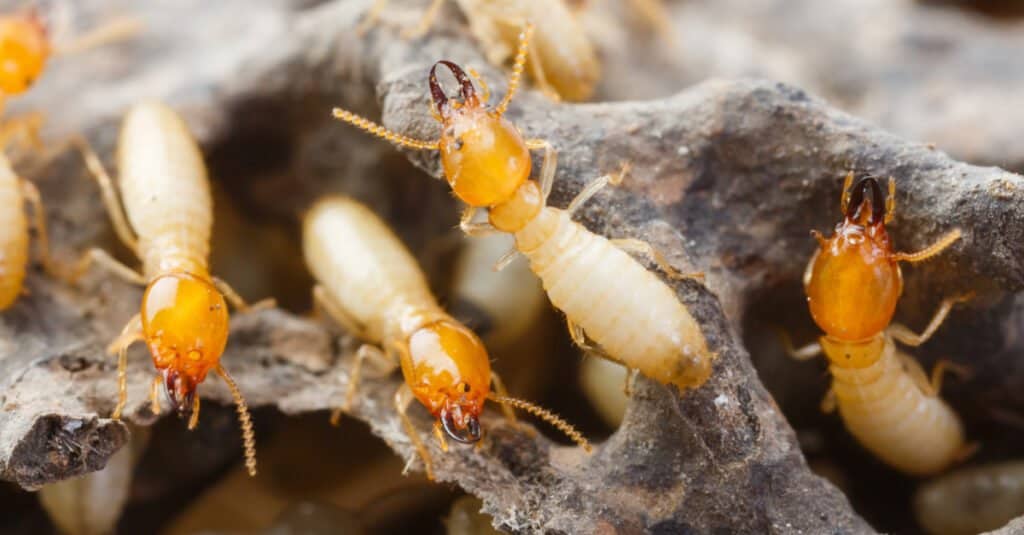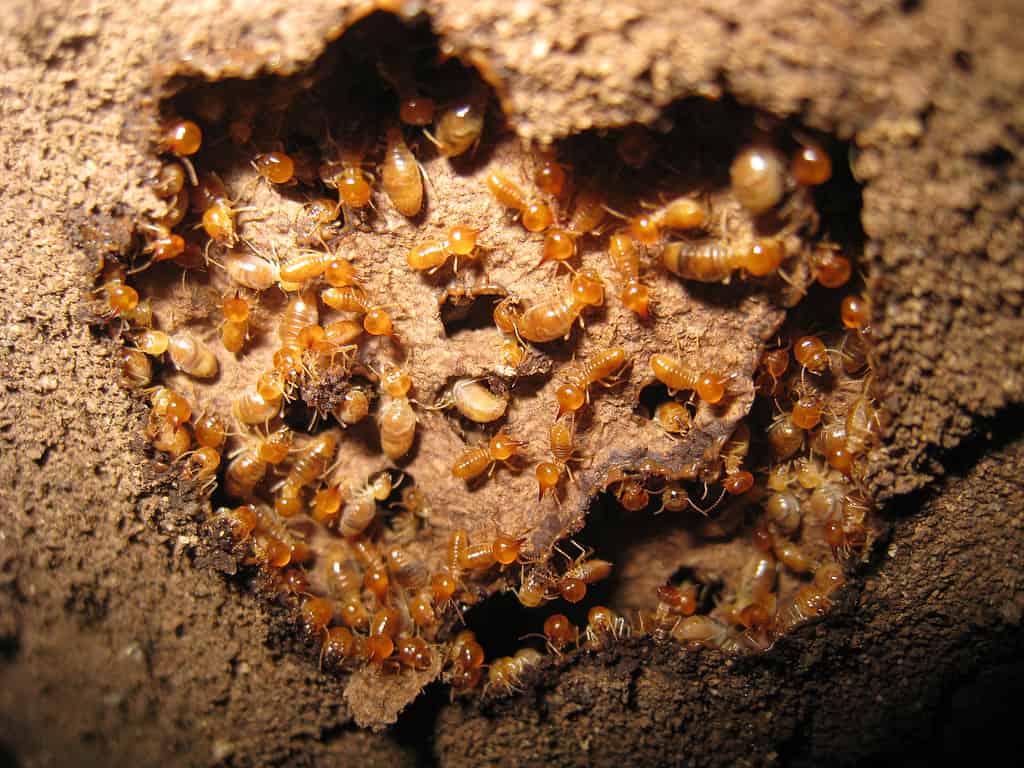
Termites progress from an egg to a nymph and then to an adult.
©7th Son Studio/Shutterstock.com
Oregon termites (Isoptera) are common because the weather is damp and humid. Most people hate to hear about termites because they know these insects can silently destroy their homes before they are discovered. Seeing a termite swarm near your home reminds you that these insects can eat you out of your house and home.
Seeing one termite or a swarm of termites, does not mean your house has been compromised. However, you should check your home, especially the wooden framing closest to the ground, annually to see if there are any signs of termite infestations.
Types Of Termites In Oregon
Subterranean Termites (Reticulitermes Hesperus)

A subterranean termite colony is underground, using mud tunnels to travel to their food.
©Cheng_Wei/iStock via Getty Images
Subterranean termites are a creamy brown color. They grow to lengths of 1/8″ and have six legs. This species lives underground. However, they build mud tube tunnels out of their excrement and use them to travel to the woods around your home. The tunnel allows them to travel back and forth undetected. They cause more than $2 billion in damages to homes each year.
Detecting the presence of these termites can be difficult. An obvious sign is the mud tunnels found on your home’s blocks and supporting beams. The winged swarming termites lose their wings, so you will find wings around the perimeters of your home, especially around doors and baseboards.
Dampwood Termites (Zootermopis Angustticollis)
The Pacific damp wood termite is a common Oregon termite. They are also found in the coastal forests of California and Washington. Pacific dampwood termites are destructive. This type of termite is helpful in the wild because it eats decaying wood and helps clean up the forest floors. However, any wood touching the ground is fair game for them.
Seeing termite swarms or alates indicates that the creatures are near your home looking for food. This species of termite has kings and queens that are dark brown. Their soldiers are a lighter brown that looks yellowish. Around your entrance doors, look for wings that may have fallen off the warmers as they entered. Also, inspect the structure of your home for any damages. If a piece of wood feels soft or spongy, immediately replace it and treat the home for termites.
What Part Of Oregon Has The Most Termites?
Oregon termites can be found all over the state. However, the areas of the state that have the greatest concentration of termites are found in the following counties:
The Risks Associated With Termites
Oregon termites pose risks to homes, especially subterranean termites.
- Wood that buckles
- Structural Damage
- Damage to floorboards
- Destruction of roofs
- Honeycombed wood
- Unsecured doors
- Plumbing problems
- Door frames that crumble when touched
How To Prevent Termites In Oregon
Oregon termites are prevented by eliminating things that attract them as much as possible. Everyone knows that termites eat wood; however, they also eat anything with cellulose in it. Things around your home that contain cellulose are paper like cardboard, sponges, fabrics, yarns, and countless items you use daily.
Prevention Tips
- Move piles of trash and debris at least 20′ from your home.
- Never stack wood directly on the ground.
- Remove the mulch from flowerbeds around your home.
- Ventilate attics and crawlspaces to reduce humidity levels in them.
- Keep gutters free of clogs and debris.
- Improve drainage to eliminate standing water close to your home.
- Fix all water leaks and dripping faucets.
The key to reducing termite damage is to treat your home and yard as soon as you recognize the signs of it. Professional treatment is the most effective termite elimination method.
Things You Should Not Do About Oregon Termites
Ignore Their Presence
If you suspect termites, call an exterminator and resolve the problem ASAP. If you ignore the problem, the insects will have more time to do more damage to your home. Once termites infiltrate your property, they destroy a house in five to six years.
Do Not Use Fire To Run The Termites Away
It might be tempting to fire a piece of wood or stump housing termites to destroy the insects. This action will put your home in danger of termites moving in faster. The winged termites are the reproductive members of the colony. When a fire burns their home, the reproductive members of the colony will fly away, and your home will be an enticing place for them.
It would be best to treat the colony before removing the wood by burning it or picking it up.
Spraying With Insect Spray Will Spread The Termites
Insect spray will cause the termites to leave their location and make a new home. Insect spray will make termites move to another location. However, these sprays will not kill or prevent termites.
FAQs
What is the most destructive termite?
The subterranean termite, called the Formosan termite, is the most destructive. These termites reproduce quickly. The quick population explosion allows them to do significant or irreparable damage to a home in one year.
Are there termite treatments that I can apply myself?
There are DIY products on the market that claim to be effective against termites. However, the solutions used by professional exterminators are more powerful and more likely to eliminate the problem rather than make the colony move to another location.
How long does it take for termites to be eliminated by professional treatment?
The time required to remove the termites from your property will depend on how many you have, where you live, and what type of treatment is applied. Most exterminators use a combination of liquid and baits. Bait stations take longer to work; however, the liquid acts quickly, so the bait station has time to finish the job.
The photo featured at the top of this post is © Criniger kolio/Shutterstock.com
Thank you for reading! Have some feedback for us? Contact the AZ Animals editorial team.







